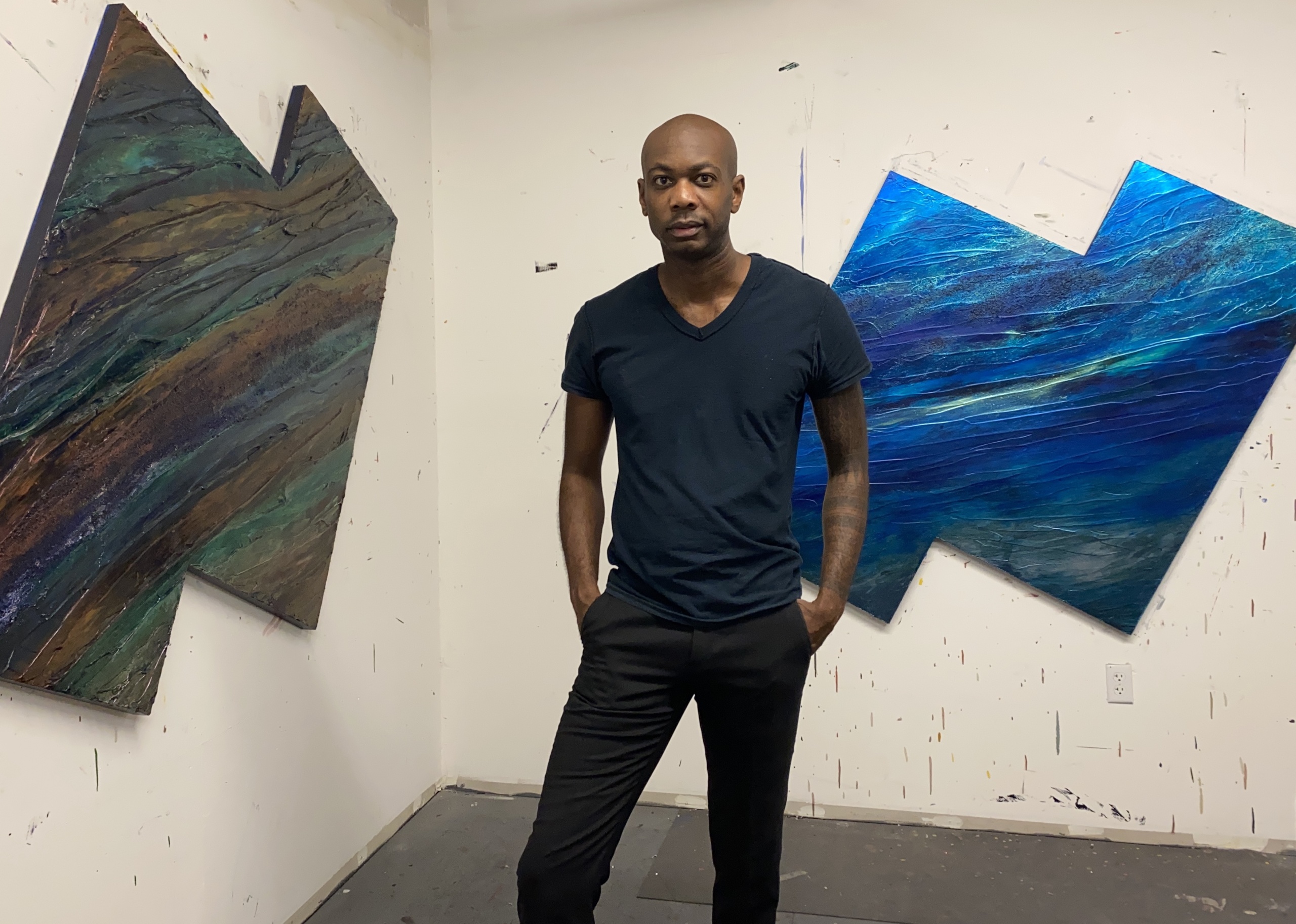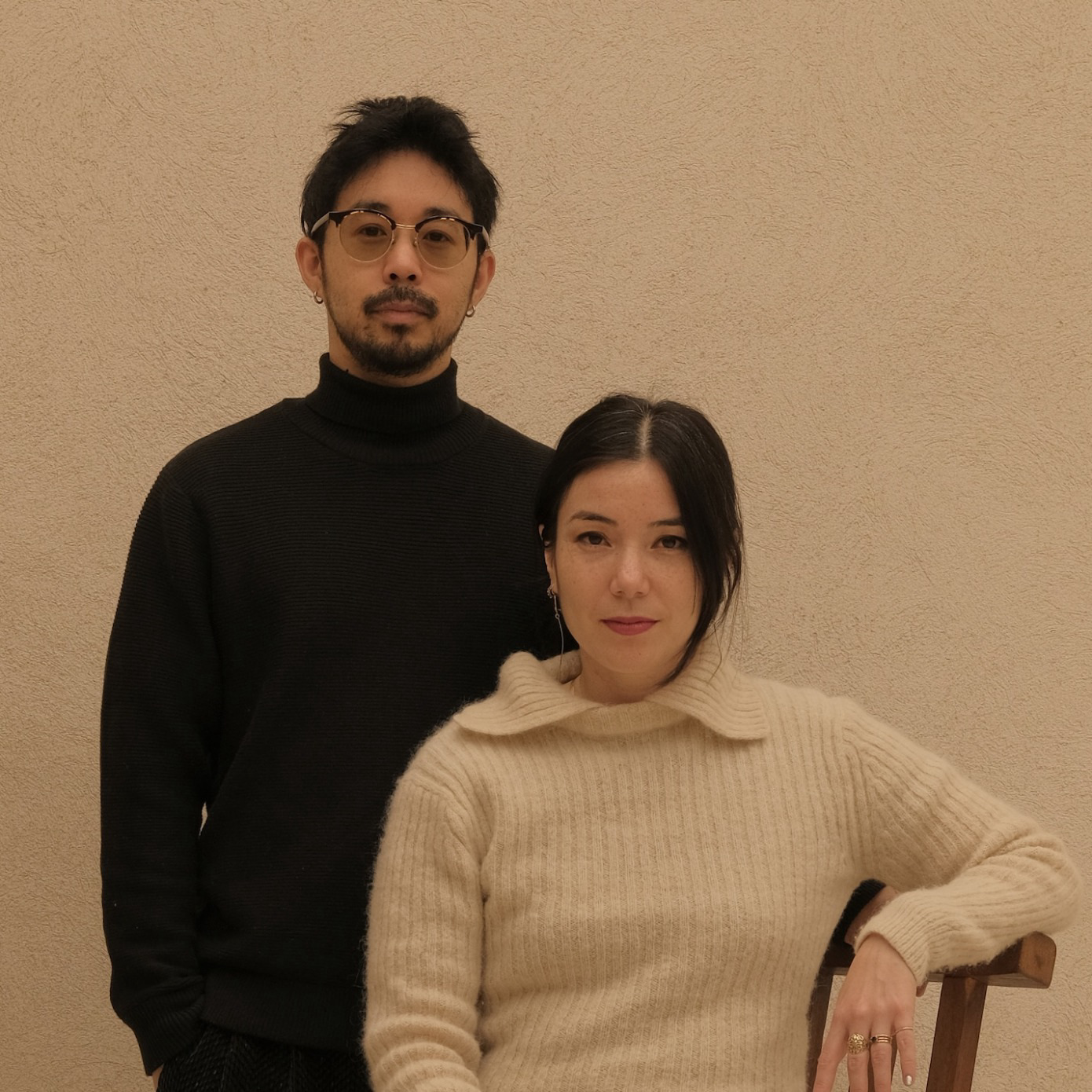
Once a week, as part of the Kossak Painting Program—a fellowship at Hunter College composed of 10 or 12 painting students—Alteronce Gumby would bring a painting or two to class to be critiqued by renowned visiting artists such as Rashid Johnson and Katherine Bernhardt.
“Everybody wanted to hang their work on the best wall for the best sunlight,” the 2013 Hunter graduate reminisces. “People would get there early, set up for class, and you were put on the spot.” The New York-based artist appreciated the challenge; more importantly, he was grateful for the opportunity to contextualize his work. He subsequently enrolled in Yale University’s Master of Fine Arts program, in large part to “keep that fire burning.” Four years and counting since Gumby earned his MFA, there’s no question that the artist has done just that.
Geometric, colorful and above all else, abstract—Gumby’s work explores the very essence of Blackness. He links this to Paris; in April 2017, the artist held a solo show at the Fondation des Etats-Unis titled “Black(ness) is Beautiful” and composed of a series of abstract paintings examining what is means to be Black through the use of color. “That really ties into what I believe to be a cornerstone of my work,” states the artist, “which is constructing these ideas about colorism and stereotypes involving race and identity politics.” The aim was—and is to this day—to redefine what color means, placing rich hues on the canvas to challenge the mind, the eye and ultimately the imagination.
Gumby admits he was inspired by artists like Robert Rauschenberg, particularly while finding his voice and style as an undergraduate. “There is a phase, I think, in every artist or painter's life where they go through a Rauschenberg moment,” he explains. “Especially if you're an abstract painter—how could you not?” Picasso, too, broke bounds in a way the artist finds inspiring. Yet, by engaging the viewer’s consciousness, Gumby has found his own unique voice and style, seeking to expand the notions through which we perceive race and identity. He attributes his efforts to a flood of childhood memories that resurfaced in early adulthood. In elementary school, the artist recalls a teacher asking him to stand and disclose his favorite color, and then to explain why. “I stood up and said, ‘My favorite color is black,’ and before I could say why, another student beside me said, ‘Your favorite color is black because you are Black.’” Gumby disagreed, defending his preference instead by stating that his favorite Superhero was Batman. But he carried this moment with him nonetheless; one might argue it’s been vital to his painting trajectory. “Over time, you start to realize that people—really even as kids—were confined to these stereotypes,” he says.
Today, Gumby dives deep into what this means. He contrasts the color of one’s skin to modern politics, identity and stereotypes involving people of color. One might argue that he’s effectively redefined Blackness at the conceptual level. Ask Gumby, and he’ll describe a sense of emancipation in his work—of liberation. He states that human beings have radicalized color as a species, citing blue as a symbol of certain emotions, of the Democratic party, of the sky and water and of the jeans so many of us wear day after day. From a young age, he sensed a simplification here—a pigeonholing of color to mean a certain thing, just as we put ourselves into these same boxes societally and create a divide. Gumby’s work skews this divide so that one day we might reconfigure it altogether.
The artist’s aim, in his words, is to break bounds, and simultaneously to unify them. “Using color and abstraction to give image to these thoughts, or to some tension, is the best way for me to unlearn what I have learned and see the world in a different way,” he conveys. If he can achieve what he’s set out to accomplish, Gumby is confident he might also shift the viewer’s consciousness.
The abstractionist began experimenting with tempered glass at the end of 2018, and so began his love of iridescent pigments. The magnified effect resonated with him and, experientially, viewers will notice a stark progression in the artist’s work over the past three years. Gumby keeps glass in his studio, which he typically paints with a few layers of acrylic to develop the right colors. This process generally takes a couple of days, and if he doesn’t like the effect, Gumby explains he might scrape the material off and start again. He works with a vision of what the painting might look like, and he’ll go on and break glass into smaller and smaller pieces before sliding it atop the painted canvas. “It’s almost like putting a puzzle together from one corner,” he elaborates.
There are ritualistic undertones, and there’s comfort in the fact that Gumby’s process is uniquely his. The artist appreciates that his paintings take time to create because this allows him to meditate on what he’s doing and why. Though the painter explains he doesn’t feel compelled to describe his process, he recognizes that his methods are a labor of love, and that the effort involved provides reassurance—a true sense of originality. “I know my work is hard to duplicate,” he says. “I feel like some people have come to my studio and been like, ‘It takes you forever to make these paintings’—like, ‘I could never.’” To this, Gumby most often replies, “I also want the viewer to look at my paintings and ask themselves "how was it made?" I think there's value in the unknown. Making paintings that are hard to duplicate gives those objects more value and gives me, as an artist, more space to develop.” He wants the viewer, and really anyone in his circle, to see the extent to which he struggles to craft each piece. There’s reward in the challenge, certainly, but Gumby wants the public to understand that he literally cuts himself to bring his glass paintings to life. Yet, the secrecy, or elusiveness, keeps things from becoming oversimplified.
To this end, there’s a sense of refinement that’s omnipresent in his work—and while Gumby could leave his abstract pieces untitled, naming his paints plays a vital role in his artistry. A fan of rap and Hip Hop from a young age, the painter has consistently paid close attention to language; there’s a sense of energy, in his view—a story and a history—that comes through in text format. “I think that words are a nice gesture to accompany an abstract painting,” says Gumby, “especially if you are trying to conjure some emotion or essence.” He goes on to communicate that the titles of his works are simply another way of allowing observers to experience his paintings. There are times when something someone says in conversation will resonate with him and he’ll incorporate their statement or perspective into his work. “I feel if you’re an artist, titling your painting Untitled is a missed opportunity to activate the viewer or yourself in the painting.”
A recent piece, Heavy is the crown (2018), is dedicated to the late Jack Whitten; a thick coat of black acrylic paint adorns the canvas alongside shards of stained glass on panel, and the work is quite literally heavy. The glass is 3/4 inches thick, Gumby describes; it covers half the canvas, diagonally, and represents a passing of the torch of sorts, paying homage to Whitten’s own black monolith paintings, for Whitten too dedicated works to people he admired: James Baldwin, Ralph Ellison, Barbara Jordan, Jacob Lawrence, LeRoi Jones aka Amiri Baraka, Terry Adkins, Maya Angelou, Ornette Coleman and Muhammad Ali, among others.
Then there’s the aptly-named My President’s orange, but my painting is still blue (2018)—oil on canvas composed of deep blues (without the slightest hint of orange, it’s worth noting). This piece is a tongue-in-cheek spinoff of another painting from 2015 entitled My president’s black, but my painting’s blue. The latter—which featured pigment sticks on canvas, with gorgeous line work and nuanced shades of blue—was living commentary for Gumby; the artist explains he was expressing his discontent for the United States, and for federal and local governments, his canvas rife with implications of police brutality and—in his words—the “countless Black bodies being murdered on social media… publicly.” Linear and geometric, both pieces feature blue as a representation of discontentment, sadness and melancholy. Tactically speaking, they’re visceral, perhaps to the point of exhibiting aggression. “My President’s orange, but my painting is still blue is kind of a continuation of that discontentment with America,” says Gumby. “Because now, here we are, with a new president…and the same problems.”
But despite this focus on the color blue, there are many hues at play in the bulk of his work—even if only metaphorically. In You think dark is just one color, but it ain’t (2020), the artist leverages acrylic and tempered glass on wood to honor Toni Morrison’s 1977 novel Song of Solomon; there’s a moment, Gumby recalls, in Morrison’s book, where two children are running for their lives after their father is falsely accused of murder and killed right in front of them. These kids are darting through the woods in search of their next safe house, and the artist felt compelled to explore the beauty—the complexity—of this looming darkness, and of Blackness in general. “This is another example to show that the color black, as we know it, is...one of the most diverse, unique and beautiful colors there is,” he says. What the canvas really represents is an amalgamation of experience—of time and light—and this, above all else, is what Gumby hopes to capture.
In light of the COVID-19 pandemic, galleries have begun to reopen, welcoming masked and socially-distanced observers, and Gumby’s work will once again be featured for in-person viewing. In October 2020, Gumby has a solo exhibition scheduled at the Parrasch Heijnen Gallery in Los Angeles. He plans to show a series of new glass paintings, all of them squares, and a number of watercolors he completed in Southern California. The artist is also participating in a group show featuring artists of color working in abstraction at False Flag in New York, with a part two at Denny Dimin later this fall.




